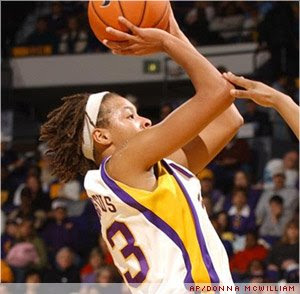 I have always admired the way former WSU grad Kyle Weaver played at the defensive end. He is going to be in the NBA for a long time for the way he plays at both ends of the floor.
I have always admired the way former WSU grad Kyle Weaver played at the defensive end. He is going to be in the NBA for a long time for the way he plays at both ends of the floor.Speaking of defense, here are five tips how players can play great defense.
1. Get in the Offensive Player's "Bubble": The bubble is the private area of an offensive player. You know you are in a player's bubble when you can make his or her shot, pass or dribble difficult.
However, you don't want to be too close to your man. Basically, you shouldn't be so close that the offensive player can beat you with one step. But at the same time, you have to be close enough that if you stretched your arms forward, you can knock the ball away.
Bother him...Irritate him...Make him worry!!!
2. Get Low: A good rule to follow is to make sure your head is lower than the head of the player you're guarding. Staying low allows you to move, much quicker.
3. Dictate Where The Ball Goes: The offensive player can either shoot, pass or dribble. You want to make shooting and passing difficult for him/her by being in their bubble...
If they dribble the ball, it'll be with their weak hand. By overplaying to the weak hand, you force him/her to use the weak hand, forcing them to go only in one direction.
The advantage of playing defense in this way is that you know what the offensive players is going to do next...You'll be prepared. By making passing or shooting difficult for him/her, and by forcing them to use their weak hand, You will know the direction the player is going.
Remember, take away the player's options and dictate where the ball is going.
4. Position Your Hands: If the offensive player is in shooting range, you should have one hand ALWAYS up, ready to bother the shot. Always get a hand in the face and see if you can't bother the shooter.
The other hand should be out and low, ready to poke at the ball if the players dribbles or passes.
So one hand up, one hand low...both hands out towards the player, ready to bother and distract a shot, pass or dribble.
5. If You Get Beat Off The Dribble: If the offensive player gets by you, react QUICKLY!!!
Immediately turn around and get super low, staying right behind your man. By getting super low, you'll be in position to poke the ball away from behind. This is an easy way to get a steal.








